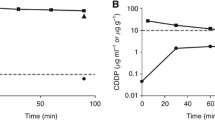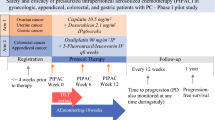Abstract
Purpose
A pharmacologic analysis of intracavitary doxorubicin in the treatment of patients with intracavitary cancer dissemination was performed to further evaluate the possible benefits of this treatment modality.
Methods
Twenty appendiceal malignancy patients with peritoneal carcinomatosis (PC), three appendiceal malignancy patients with direct extension into the pleural cavity, 20 patients with peritoneal mesothelioma and one patient with pleural mesothelioma were available for pharmacologic monitoring. After intraperitoneal or intrapleural administration of doxorubicin, plasma and peritoneal fluid samples were obtained at 15, 30, 45, 60 and 90 min in all patients. After intrapleural administration, plasma and pleural fluid samples were collected at similar intervals. Tumor and normal tissues were obtained when available. Doxorubicin concentrations were determined by high-performance liquid chromatography (HPLC).
Results
Intraperitoneal doxorubicin showed a prolonged retention in the peritoneal cavity. Doxorubicin concentrations in tumor tissue were consistently elevated above intraperitoneal concentrations from 30 through 90 min. For appendiceal malignancy, the concentrations of doxorubicin were significantly higher in minimally aggressive mucinous tumors. Pleural chemotherapy solutions retained doxorubicin to a greater extent than peritoneal fluid.
Conclusions
Doxorubicin shows characteristics favorable for intracavitary administration with sequestration of doxorubicin in cancer nodules.




Similar content being viewed by others
References
Zoetmulder FA (1982) Modelstudies over het colorectale carcinoom. Amsterdam, Rodopi
Sugarbaker PH, Cunliffe WJ, Belliveau J et al (1989) Rationale for integrating early postoperative intraperitoneal chemotherapy into the surgical treatment of gastrointestinal cancer. Semin Oncol 16(4):83–97
Weiss L (1990) Metastatic inefficiency. Adv Cancer Res 54:159–211
Sugarbaker PH (2003) Peritonectomy procedures. Surg Oncol Clin N Am 12(3):703–727
Alberts DS, Liu PY, Hannigan EV et al (1996) Intraperitoneal cisplatin plus intravenous cyclophosphamide versus intravenous cisplatin plus intravenous cyclophosphamide for stage III ovarian cancer. N Engl J Med 335(6):1950–1955
Markman M, Bundy BN, Alberts DS et al (2001) Phase III trial of standard-dose intravenous cisplatin plus paclitaxel versus moderately high-dose carboplatin followed by intravenous paclitaxel and intraperitoneal cisplatin in small-volume stage III ovarian carcinoma: an intergroup study of the Gynecologic Oncology Group, Southwestern Oncology Group, and Eastern Oncology Group. J Clin Oncol 19(4):1001–1007
Armstrong DK, Bundy B, Wenzel L et al (2006) Intraperitoneal cisplatin and paclitaxel in ovarian cancer. N Engl J Med 354(1):34–43
Verwaal VJ, Van Ruth S, De Bree E et al (2003) Randomized trial of cytoreduction and hyperthermic intraperitoneal chemotherapy versus systemic chemotherapy and palliative surgery in patients with peritoneal carcinomatosis of colorectal cancer. J Clin Oncol 21(20):3737–3743
Sugarbaker PH (2005) An instrument to provide containment of intraoperative intraperitoneal chemotherapy with optimized distribution. J Surg Oncol 92(2):142–146
Cummings J, Stuart JFB, Calman KC (1984) Determination of adriamycin, adriamycinol and their 7-deoxyaclycones in human serum by high-performance liquid chromatography. J Chromatogr 311:125–133
Ronnett BM, Zahn CM, Kurman RJ et al (1995) Disseminated peritoneal adenomucinosis and peritoneal mucinous carcinomatosis: a clinicopathologic analysis of 109 cases with emphasis on distinguishing pathologic features, site of origin, prognosis, and relationship to “pseudomyxoma peritonei”. Am J Surg Pathol 19(12):1390–1408
Cerruto CA, Brun EA, Chang D, Sugarbaker PH (2006) Prognostic significance of histomorphologic parameters in diffuse malignant peritoneal mesothelioma. Arch Pathol Lab Med 130(11):1654–1661
Tritton TR (1991) Cell surface actions of adriamycin. Pharmacol Ther 49:293–309
Hahn GM, Braun J, Har-Kedar I (1975) Thermochemotherapy: synergism between hyperthermia (42–43°) and adriamycin (or bleomycin) in mammalian cell inactivation. Proc Nat Acad Sci 72(3):937–940
Lane P, Vichi P, Bain DL et al (1987) Temperature dependence studies of adriamycin uptake and cytotoxocity. Cancer Res 42:4038–4042
Carter SK (1981) Adriamycin—a review. J Natl Cancer Inst 55:1265–1274
Johansen PB (1981) Doxorubicin pharmacokinetics after intravenous and intraperitoneal administration in the nude mouse. Cancer Chemother Pharmacol 5:267–270
Ozols RF, Young RC, Speyer JL et al (1982) Phase I and pharmacological studies of adriamycin administered intraperitoneally to patients with ovarian cancer. Cancer Res 42:4265–4269
Ozols RF, Grotzinger KR, Fisher RI et al (1979) Kinetic characterization and response to chemotherapy in a transplantable murine ovarian cancer. Cancer Res 39:3202–3208
Ozols RF, Locker GY, Doroshow JH et al (1979) Pharmacokinetics and tissue penetration in murine ovarian cancer. Cancer Res 39:3209–3214
Ozols RF, Willson JKV, Weltz MD et al (1980) Inhibition of human ovarian cancer colony formation by adriamycin and its major metabolites. Cancer Res 40:4109–4112
Sugarbaker PH, Mora JT, Carmignani P, Stuart OA, Yoo D (2005) Update on chemotherapeutic agents utilized for perioperative intraperitoneal chemotherapy. Oncologist 10(2):112–122
Roboz J, Jacobs AJ, Holland JF et al (1981) Intraperitoneal infusion of doxorubicin in the treatment of gynecologic carcinomas. Med Pediatr Oncol 9:245–250
Yan TD, Welch L, Black D et al (2007) A systematic review on the efficacy of cytoreductive surgery combined with perioperative intraperitoneal chemotherapy for diffuse malignancy peritoneal mesothelioma. Ann Oncol 18(5):827–834
Raspagliesi F, Kusamura S, Campos Torres JC et al (2006) Cytoreduction combined with intraperitoneal hyperthermic perfusion chemotherapy in advanced/recurrent ovarian cancer patients: the experience of National Cancer Institute of Milan. Eur J Surg Oncol 32(6):671–675
Yan TD, Black D, Savady R et al (2007) A systematic review on the efficacy of cytoreductive surgery and perioperative intraperitoneal chemotherapy for pseudomyxoma peritonei. Ann Surg Oncol 14(2):484–492
Stelin G, Rippe B (1990) A phenomenological interpretation of the variation in dialysate volume with dwell time in CAPD. Kidney Int 38(3):465–472
Ceelen WP, Påhlman L, Mahteme H (2006) Pharmacodynamic aspects of intraperitoneal cytotoxic therapy. In Peritoneal carcinomatosis: a multidisciplinary approach. Cancer Treat Res, Springer, 195–214
Dedrick RL, Flessner MF (1997) Pharmacokinetic problems in peritoneal drug administration: tissue penetration and surface exposure. J Natl Cancer Inst 89(7):480–487
Sugarbaker PH, Stuart OA (2007) Pharmacokinetic and phase II study of heated intraoperative intraperitoneal melphalan. Cancer Chemother Pharmacol 59(2):151–155
Conflict of Interest
None.
Author information
Authors and Affiliations
Corresponding author
Rights and permissions
About this article
Cite this article
Van der Speeten, K., Stuart, O.A., Mahteme, H. et al. A pharmacologic analysis of intraoperative intracavitary cancer chemotherapy with doxorubicin. Cancer Chemother Pharmacol 63, 799–805 (2009). https://doi.org/10.1007/s00280-008-0800-0
Received:
Accepted:
Published:
Issue Date:
DOI: https://doi.org/10.1007/s00280-008-0800-0




